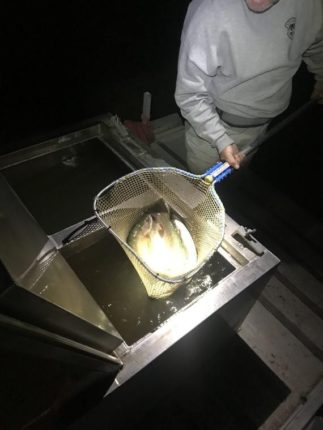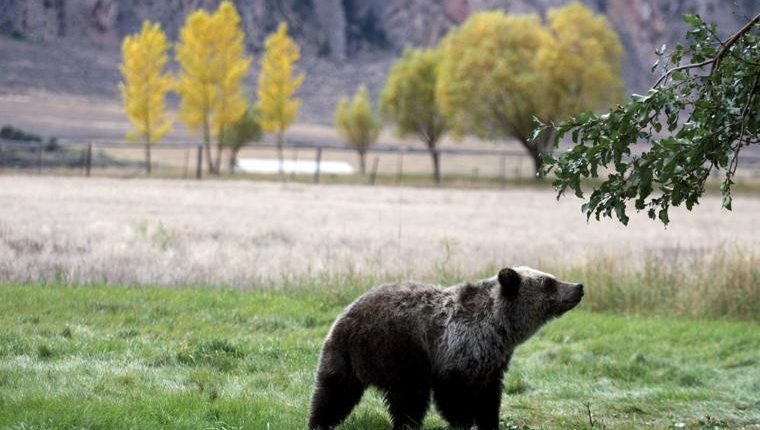If you are planning on hunting big game this year with a rifle, I assume you know what caliber of rifle you plan to use. There are certainly many fine choices of rifle calibers to choose from depending on how far you expect to have to shoot, how much r…
Category: Outdoors
Idaho Fish and Game relocates fish from Treasureton Reservoir salvage
On Tuesday, Idaho Fish and Game personnel relocated fish from Treasureton Reservoir to other water bodies in the Preston area. Using electrofishing equipment, crews were able to relocate 37 rainbow trout, ranging in size from 15 to 24 inches, to Lamont…
Idaho Fish and Game relocates fish from Treasureton Reservoir salvage
On Tuesday, Idaho Fish and Game personnel relocated fish from Treasureton Reservoir to other water bodies in the Preston area. Using electrofishing equipment, crews were able to relocate 37 rainbow trout, ranging in size from 15 to 24 inches, to Lamont…
Officials say rancher shot, injured wolf in northeast Washington
Washington state wildlife officials say a rancher in northeast Washington shot and injured a wolf last week.The Department of Fish and Wildlife said Tuesday that biologists found the collared wolf on Monday injured but mobile. The shooting happened in …
Officials say rancher shot, injured wolf in northeast Washington
Washington state wildlife officials say a rancher in northeast Washington shot and injured a wolf last week.The Department of Fish and Wildlife said Tuesday that biologists found the collared wolf on Monday injured but mobile. The shooting happened in …
Wildlife groups press judge to nix Yellowstone-area grizzly hunts
HELENA, Montana (AP) — Wildlife advocates hope to convince a judge Thursday that grizzly bears living in the Yellowstone National Park area face too many threats to their survival to add trophy hunting to the mix.
Over two dozen conservation groups, Native American tribes and individuals will argue in a Montana courtroom that approximately 700 Yellowstone grizzlies should continue to be protected under the Endangered Species Act because of conflicts with humans, changing food sources and a host of other obstacles.
Wyoming and Idaho have set Saturday as the opening day for the first grizzly hunting season in the Lower 48 states since 1974. U.S. District Judge Dana Christensen said he will rule by then on whether to allow the hunts to proceed.
An appeal to the 9th U.S. Circuit Court of Appeals is likely by whoever is on the losing side.
The advocacy groups claim the U.S. Fish and Wildlife Service’s decision last year that Yellowstone grizzlies are no longer a threatened species was based on faulty science. They also say they don’t trust the three states that have taken over bear management — Wyoming, Montana and Idaho — will ensure the bears’ survival.
“The way the Endangered Species Act works is you err or the side of caution; you don’t err on the side of removing protections and hope it all works out,” said Tim Preso, an attorney for Earthjustice representing the Sierra Club, the Center for Biological Diversity, the National Parks Conservation Association and the Northern Cheyenne Tribe.
Justice Department lawyers representing the Fish and Wildlife Service reject the plaintiffs’ claims and say the Yellowstone grizzlies are one of the most-studied and best-managed bear species in the world.
Officials from the three states say they are collaborating to adjust hunting quotas each year based on total grizzly deaths and that will ensure the bear population isn’t imperiled.
“The way this grizzly bear plan was set up is to look closely at population and mortality across the three states where the grizzly bear lives,” said Wyoming Game and Fish spokesman Renny MacKay. “We do a very conservative population estimate and we do a more liberal mortality estimate.”
The population of grizzlies living in Yellowstone was classified as a threatened species in 1975, when its number had fallen to 136. The Fish and Wildlife Service initially declared a successful recovery for the Yellowstone population in 2007, but a federal judge ordered protections to remain in place while wildlife officials studied whether the decline of a major food source, whitebark pine seeds, could threaten the bears’ survival.
In 2017, the federal agency concluded that it had addressed all threats and ruled that the grizzlies were no longer a threatened species needing restrictive federal protections.
That prompted six lawsuits challenging the agency’s decision. Those lawsuits have been consolidated into one case that Christensen heard Thursday.
Idaho’s hunting quota is one bear. Wyoming’s hunt is in two phases: Sept. 1 opens the season in an outlying area with a quota of 12 bears, and Sept. 15 starts the season in prime grizzly habitat near Yellowstone and Grand Teton national parks. One female or nine males can be killed in those areas.
Wildlife officials in those states say they’re ready for opening day, which would be Wyoming’s first grizzly hunt since 1974 and Idaho’s first since 1946. Twelve hunters in Wyoming and one in Idaho have been issued licenses out of the thousands who applied.
“One thing we told them is that the hunt may not happen or it could be affected in some way,” MacKay said.
Montana officials decided not to hold a hunt this year. Bear hunting is not allowed in Yellowstone or Grand Teton.
The threatened species classification applies to all bears living in the Lower 48 states outside of the Yellowstone population. It doesn’t apply to Alaska, where bear hunts are held each spring and fall and the population numbers about 30,000.
The Fish and Wildlife Service has been moving toward lifting federal protections for another group of approximately 1,000 bears living in Montana’s Glacier National Park and the Bob Marshall Wilderness, but first wants to see how Christensen decides the Yellowstone case.
Wildlife groups press judge to nix Yellowstone-area grizzly hunts
HELENA, Montana (AP) — Wildlife advocates hope to convince a judge Thursday that grizzly bears living in the Yellowstone National Park area face too many threats to their survival to add trophy hunting to the mix.
Over two dozen conservation groups, Native American tribes and individuals will argue in a Montana courtroom that approximately 700 Yellowstone grizzlies should continue to be protected under the Endangered Species Act because of conflicts with humans, changing food sources and a host of other obstacles.
Wyoming and Idaho have set Saturday as the opening day for the first grizzly hunting season in the Lower 48 states since 1974. U.S. District Judge Dana Christensen said he will rule by then on whether to allow the hunts to proceed.
An appeal to the 9th U.S. Circuit Court of Appeals is likely by whoever is on the losing side.
The advocacy groups claim the U.S. Fish and Wildlife Service’s decision last year that Yellowstone grizzlies are no longer a threatened species was based on faulty science. They also say they don’t trust the three states that have taken over bear management — Wyoming, Montana and Idaho — will ensure the bears’ survival.
“The way the Endangered Species Act works is you err or the side of caution; you don’t err on the side of removing protections and hope it all works out,” said Tim Preso, an attorney for Earthjustice representing the Sierra Club, the Center for Biological Diversity, the National Parks Conservation Association and the Northern Cheyenne Tribe.
Justice Department lawyers representing the Fish and Wildlife Service reject the plaintiffs’ claims and say the Yellowstone grizzlies are one of the most-studied and best-managed bear species in the world.
Officials from the three states say they are collaborating to adjust hunting quotas each year based on total grizzly deaths and that will ensure the bear population isn’t imperiled.
“The way this grizzly bear plan was set up is to look closely at population and mortality across the three states where the grizzly bear lives,” said Wyoming Game and Fish spokesman Renny MacKay. “We do a very conservative population estimate and we do a more liberal mortality estimate.”
The population of grizzlies living in Yellowstone was classified as a threatened species in 1975, when its number had fallen to 136. The Fish and Wildlife Service initially declared a successful recovery for the Yellowstone population in 2007, but a federal judge ordered protections to remain in place while wildlife officials studied whether the decline of a major food source, whitebark pine seeds, could threaten the bears’ survival.
In 2017, the federal agency concluded that it had addressed all threats and ruled that the grizzlies were no longer a threatened species needing restrictive federal protections.
That prompted six lawsuits challenging the agency’s decision. Those lawsuits have been consolidated into one case that Christensen heard Thursday.
Idaho’s hunting quota is one bear. Wyoming’s hunt is in two phases: Sept. 1 opens the season in an outlying area with a quota of 12 bears, and Sept. 15 starts the season in prime grizzly habitat near Yellowstone and Grand Teton national parks. One female or nine males can be killed in those areas.
Wildlife officials in those states say they’re ready for opening day, which would be Wyoming’s first grizzly hunt since 1974 and Idaho’s first since 1946. Twelve hunters in Wyoming and one in Idaho have been issued licenses out of the thousands who applied.
“One thing we told them is that the hunt may not happen or it could be affected in some way,” MacKay said.
Montana officials decided not to hold a hunt this year. Bear hunting is not allowed in Yellowstone or Grand Teton.
The threatened species classification applies to all bears living in the Lower 48 states outside of the Yellowstone population. It doesn’t apply to Alaska, where bear hunts are held each spring and fall and the population numbers about 30,000.
The Fish and Wildlife Service has been moving toward lifting federal protections for another group of approximately 1,000 bears living in Montana’s Glacier National Park and the Bob Marshall Wilderness, but first wants to see how Christensen decides the Yellowstone case.
Biologists begin bear trapping in Yellowstone for research purposes
YELLOWSTONE NATIONAL PARK — As part of ongoing efforts to monitor the population of grizzly bears and black bears in the Greater Yellowstone Ecosystem, Yellowstone National Park and the the United States Geological Survey would like to inform the public that biologists with the National Park Service and Interagency Grizzly Bear Study Team will be conducting scientific grizzly bear and black bear research operations in Yellowstone National Park from Aug. 21 through Oct. 31.
Team members will bait and capture bears at several remote sites within Yellowstone National Park. Once captured, the bears are anesthetized to allow wildlife biologists to radio-collar and collect scientific samples for study. All captures and handling are done in accordance with strict protocols developed by the IGBST.
None of the capture sites in the park will be located near any established hiking trails or backcountry campsites, and all sites will have posted warnings for the closure perimeter. Potential access points will also be posted with warning signs for the closure area. Backcountry users who come upon any of these posted areas need to heed the warnings and stay out of the area.
The Interagency Grizzly Bear Study Team was established in 1973 to collaboratively monitor and manage ecosystem bears on an interagency basis. The gathering of critical data on bears is part of a long-term research and monitoring effort to help wildlife managers devise and implement programs to support the ongoing conservation of Yellowstone’s grizzly bear and black bear populations.
The IGBST is composed of representatives of the U.S. Geological Survey, the National Park Service, the U.S. Fish and Wildlife Service, the U.S. Forest Service, the Eastern Shoshone and Northern Arapaho Tribal Fish and Game Department and the states of Idaho, Montana and Wyoming.
For more information regarding grizzly bear research efforts, call 406-994-6675.
Biologists begin bear trapping in Yellowstone for research purposes
YELLOWSTONE NATIONAL PARK — As part of ongoing efforts to monitor the population of grizzly bears and black bears in the Greater Yellowstone Ecosystem, Yellowstone National Park and the the United States Geological Survey would like to inform the public that biologists with the National Park Service and Interagency Grizzly Bear Study Team will be conducting scientific grizzly bear and black bear research operations in Yellowstone National Park from Aug. 21 through Oct. 31.
Team members will bait and capture bears at several remote sites within Yellowstone National Park. Once captured, the bears are anesthetized to allow wildlife biologists to radio-collar and collect scientific samples for study. All captures and handling are done in accordance with strict protocols developed by the IGBST.
None of the capture sites in the park will be located near any established hiking trails or backcountry campsites, and all sites will have posted warnings for the closure perimeter. Potential access points will also be posted with warning signs for the closure area. Backcountry users who come upon any of these posted areas need to heed the warnings and stay out of the area.
The Interagency Grizzly Bear Study Team was established in 1973 to collaboratively monitor and manage ecosystem bears on an interagency basis. The gathering of critical data on bears is part of a long-term research and monitoring effort to help wildlife managers devise and implement programs to support the ongoing conservation of Yellowstone’s grizzly bear and black bear populations.
The IGBST is composed of representatives of the U.S. Geological Survey, the National Park Service, the U.S. Fish and Wildlife Service, the U.S. Forest Service, the Eastern Shoshone and Northern Arapaho Tribal Fish and Game Department and the states of Idaho, Montana and Wyoming.
For more information regarding grizzly bear research efforts, call 406-994-6675.
Man pinned overnight by boulders while hiking in Sawtooths ‘isn’t your normal 71-year-old’
BOISE — A Boise man hiking in the Sawtooth Mountains southeast of Grandjean survived last week after he was struck by two boulders.
Dick Ross, 71, suffered breaks to both of his legs Thursday when a refrigerator-sized boulder rolled over them southeast of Grandjean Peak. A second boulder, the size of an ottoman, then struck Ross in the torso and pinned him to the ground.
Ross spent the night trapped under the boulder, until he was rescued Friday morning.
Ross had been hiking with a friend for several days but decided to return early to his car so he could drive home to care for a new puppy, said his wife, Brenda Ross.
“He’s just lucky that he’s alive and that he had the whereabouts to survive for the 15 hours on the mountainside,” she told the Idaho Statesman on Monday.
A hiker heard Ross’s screams for help a couple of hours after he was struck by the boulders. The hiker was some distance away, and the two men yelled back and forth. Brenda Ross said she believes the man hiked out to a place where he could get cell service and called 911.
She believes the man may have also come across another group of hikers who arrived four hours later to the site where Ross was trapped. One of the men was an emergency medical technician who examined Ross’s legs.
“They got Dick settled in for the night and helped him get his warm clothes on,” Brenda Ross said.
A dispatcher at the Boise County Sheriff’s Office said they received a call at 3 a.m. Friday and notified Idaho Emergency Medical Services, which arranged for an emergency medical helicopter crew to get the boulder off Ross and bring him to Saint Alphonsus Regional Medical Center in Boise.
Ross underwent surgery on Friday and again on Monday. He’ll likely need additional surgery on his left leg.
Brenda Ross said her husband had never broken a bone in his body before and took the accident remarkably well. He’s spoken to friends on the phone and in his hospital room and has retained his sense of humor, she said.
“Boy, did he enjoy his helicopter flight,” she said.
Brenda Ross says she expects a long recovery.
“I know there are going to be some hard times to come, because he’s not a person to be sitting around in a wheelchair for very long,” she said.
Steven Hawk, who said he’s known Ross for about three years, said he is amazed at how busy his friend remains.
“Dick Ross isn’t your normal 71-year-old,” Hawk wrote in an email to the Statesman. “He’s more active than most 20-somethings. He skis Bogus almost every year in the winter, hikes the Sawtooths in the summer and flies his remote-controlled planes every morning at 6 a.m.”




